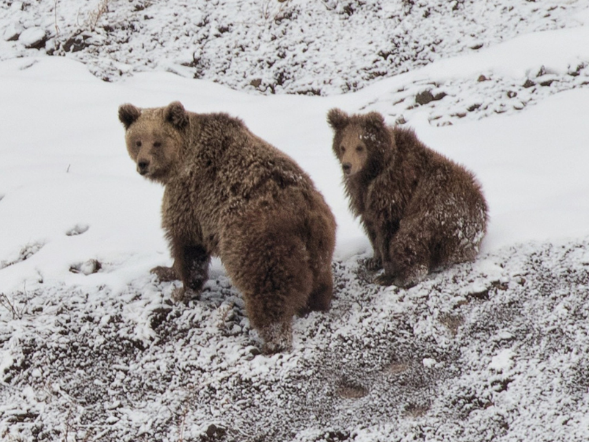Important Facts For Prelims
Himalayan Brown Bear
- 05 Jun 2023
- 6 min read
Why in News?
The Himalayan brown bear (Ursus arctos isabellinus) population in Kashmir is facing numerous challenges that threaten both their survival and human safety.
- Recent incidents of bears entering residential areas and wrecking graveyards have raised concerns among local communities.
- These incidents highlight the urgent need to address the underlying factors causing this behavior and safeguard the habitat of this critically endangered species.
What are Himalayan Brown Bears?
- About:
- Himalayan brown bears are a subspecies of brown bears that inhabit the high-altitude regions of the Himalayas, ranging from Pakistan to Bhutan.
- They have thick fur that is most often sandy or reddish-brown in color.
- They can grow up to 2.2 meters long and weigh up to 250 kilograms.
- Status:
- IUCN Red List- Critically Endangered
- Brown bear (Ursus arctos) is listed as Least Concern.
- CITES - Appendix I.
- Only the populations of Bhutan, China, Mexico and Mongolia; all other populations are included in Appendix II.
- Indian Wildlife (Protection) Act of 1972 - Schedule 1.
- IUCN Red List- Critically Endangered
- Food:
- Omnivorous.
- Behavior:
- They are nocturnal, and their sense of smell is acutely developed and believed to be their principal means of finding food.
- Threat:
- Human-animal conflict, rapid habitat loss, poaching for fur, claws, and organs, and, in some rare cases, bear baiting.
- Range:
- North-western and central Himalaya, including India, Pakistan, Nepal, the Tibetan Autonomous Region of China, and Bhutan.
- Challenges:
- Insufficient Food Sources and Altered Behavior:
- The bears' peculiar behavior of digging up graves and wandering into residential areas can be attributed to insufficient food in their natural habitats.
- A study conducted by Wildlife SOS, an organization established with the goal of making lasting changes to protect and conserve India's natural heritage, forests, and biodiversity, revealed that a significant portion of the bears' diet in Kashmir consists of scavenged garbage, including plastic bags, chocolate wrappers, and other edible waste.
- This disrupts their natural foraging patterns and alters their behavior, leading to conflicts with humans.
- Improper disposal of kitchen waste by both local residents and hoteliers near bear habitats has provided easy access to food, leading to frequent interactions between bears and humans.
- This altered behavior, coupled with complacency in hunting for food, has created a dependence on human-generated waste, further exacerbating conflicts.
- Restricted Distribution and Declining Population:
- The restricted distribution of the Himalayan brown bear in the alpine meadows of the Himalayas has made it challenging for researchers to gather comprehensive data on the species.
- Habitat destruction caused by factors like habitat encroachment, tourism, and grazing pressure has contributed to the declining population of bears.
- With only an estimated 500-750 bears left in India, urgent conservation efforts are required to ensure their survival.
- Future Threats and Conservation Recommendations:
- The Himalayan brown bear's future remains bleak, as a study predicts a decline of about 73% of their habitat by 2050 in the western Himalayas.
- Climate change poses a significant risk, necessitating preemptive spatial planning of protected areas to ensure the long-term viability of the species.
- Conservation efforts should focus on habitat preservation, creating biological corridors, and promoting responsible waste management to minimize human-bear conflicts.
- Should Strengthen the legal protection and enforcement by implementing the Wildlife (Protection) Act of 2022 and CITES regulations.
- Insufficient Food Sources and Altered Behavior:
UPSC Civil Services Examination, Previous Year Question (PYQ)
Q. Consider the following fauna: (2023)
- Lion-tailed Macaque
- Malabar Civet
- Sambar Deer
How many of the above are generally nocturnal or most active after sunset?
(a) Only one
(b) Only two
(c) All three
(d) None
Ans: (b)
- The lion-tailed macaque is not a nocturnal animal. It is an arboreal and diurnal creature, they sleep at night in trees ( typically, high in the canopy of rainforest). These macaques are territorial and very communicative animals. Hence, 1 is not correct.
- Malabar civet is primarily nocturnal. It is a small, carnivorous mammal that is native to the Western Ghats region of India.
- It has a solitary and secretive nature, making it challenging to observe in the wild. Its nocturnal behavior helps it avoid predators and increases its chances of finding prey in the darkness. Hence, 2 is correct.
- Sambar deer are nocturnal. They more commonly communicate by scent marking and foot stamping. They prefer the dense cover of deciduous shrubs and grass. Hence, 3 is correct.
- Hence, option (b) is correct.







